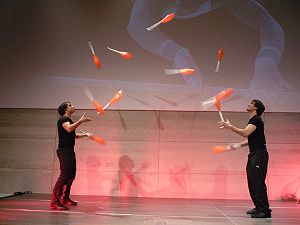- Modern juggling culture
-
Since the late 1980s, a large juggling culture has developed, revolving around local clubs and organizations, special events, shows, magazines, video sharing websites, Internet forums, competitions and juggling conventions. Populating the scene are many juggling celebrities who are notable for being good or creative jugglers, entertaining performers, convention organizers, experts in their field, having a strong presence online or just for having an interesting personality, character or style.
It has developed into a fully formed subculture, with tens of thousands of followers.[1]
Contents
Clubs and organizations
Most cities and large towns have juggling clubs, where anyone is welcome to learn and share skills. Many universities and colleges have juggling or circus skills societies. There are also many community circus groups that usually aim to teach young people and put on shows. The Internet Juggling Database maintains a searchable database of most juggling clubs.[2]
The first organization to promote juggling and help jugglers was the International Jugglers' Association (IJA), based almost entirely in North America.[3] The World Juggling Federation (WJF) promotes more technical juggling, in contrast to the "performing" emphasis of the IJA. The European Juggling Association facilitates the annual European Juggling Convention and promotes juggling in Europe.[4] Various countries have national associations, including Italy, Spain, and Switzerland. There is also the Christian Jugglers Association.[5]
Magazines
Kaskade is a European juggling magazine, published in both English and German.[6] Juggle is the official publication of the IJA and focuses on the North American scene.[7] Juggling Magazine is published in Italy[8] and Newton Las Pelotas is published in Argentina and Spain for the Latin American readership.[9]
Events
Main article: Juggling conventionWorld Juggling Day is the second or third Saturday in June.[citation needed] There are events organized worldwide to teach people how to juggle, to promote juggling, or for jugglers to get together and celebrate.
Many countries, cities, or juggling clubs hold an annual juggling convention. These are the backbone of the juggling scene, because the events regularly bring jugglers from a wide area together. The attendance of a convention can be anything from a few dozen to a few thousand people. The principal focus of most juggling conventions is the main hall, where anybody can juggle, share tricks or try out multi-person passing patterns. There will often be more formal workshops, in which experts work with small groups on skills and techniques. Most juggling conventions also include a big show (open to the general public), competitions, and juggling games. Many juggling conventions host some kind of renegade show, an open stage where anyone can perform at short notice. The Internet Juggling Database maintains a searchable database of past and upcoming conventions.[10]
Objects
Modern juggling has moved away from the more dangerous objects, including the chainsaw and machete. However, juggling with flaming torches remains a crowd favourite and is regularly used by jugglers in the modern day. While beginners mainly use balls, both balls and clubs remain staples of juggling.
References
- ^ Billy Baker (2007-03-05). "Up for the count, Jugglers may pop out on streets this spring, but the real action is in a thriving Hub subculture". The Boston Globe. http://www.boston.com/news/local/articles/2007/03/25/up_for_the_count/. Retrieved 2008-08-04.
- ^ http://www.jugglingdb.com/clubs
- ^ http://www.juggle.org
- ^ http://www.eja.net
- ^ http://www.juggling.org/~cja
- ^ http://www.kaskade.de
- ^ http://www.jugglemagazine.com
- ^ http://www.jugglingmagazine.it/new
- ^ http://www.newtonlaspelotas.net
- ^ http://www.jugglingdb.com/events/
See also
Categories:
Wikimedia Foundation. 2010.

